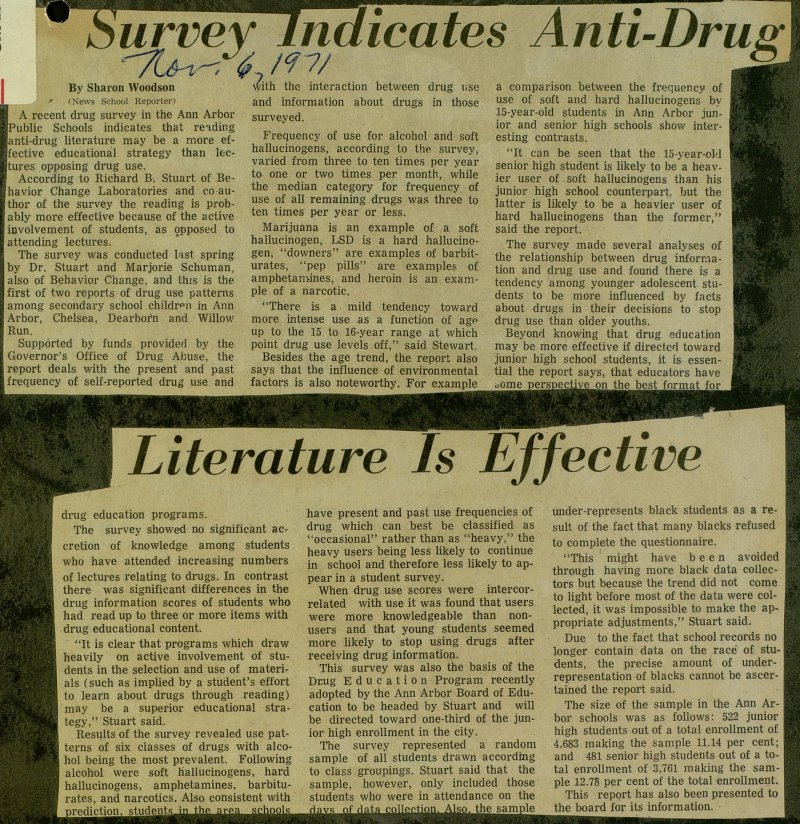Survey Indicates Anti-drug Literature Is Effective

A recent drug survey in the Ann Arbor Public Schools indicates that reiding anti-drug literature may be a more eftective educational strategy than lectures opposing drug use. According to Richard B. Stuart of Behavior Change Laboratories and co author of the survey the reading is probably more effective because of the active involvement of students, as opposed to attending lectures. The survey was conducted last spring by Dr. Stuart and Marjorie Schuman, also of Behavior Change, and this is the first of two reports of drug use patterns among secondary school childrn in Ann Arbor, Chelsea, Dearbofn and Willow Run. Supported by funds provided by the Governor's Office of Drug Abuse, the report deals with the present and past frequency of self-reported drug use and with the interaction between drug r.se and information about drugs in those surveyed. Frequency of use for alcohol and soft hallucinogens, according to the survey, varied from three to ten times per year to one or two times per month, while the median category for frequency of use of all remaining drugs was three to ten times per year or less. Marijuana is an example of a soft hallucinogen, LSD is a hard hallucinogen, "downers" are examples of barbiturates, "pep pills" are examples of amphetamines, and heroin is an example of a narcotic. "There is a mild tendency toward more intense use as a function of agt up to the 15 to 16-year range at which point drug use levéis off," said Stewart. Besides the age trend, the report also says that the influence of environmental factors is also noteworthy. For example a comparison between the frequency of use of soft and hard hallucinogens by 15-year-old students in Ann Arbor junior and senior high schools show interesting contrasts. "It can be seen that the 15-year-old senior high student is likely to be a heavier user of soft hallucinogens than his junior high school counterpart, but the latter is likely to be a heavier user of hard hallucinogens than the former," said the report. The survey made several analyses of the relationship between drug inforr.iation and drug use and found (here is a tendency among younger adolescent students to be more influenced by facts about drugs in their decisions to stop drug use than older youths. Beyond knowing that drug education may be more effective if directe! toward junior high school students, it is essential the report says, that educators have oome perspective on the best format for drug education programs. The survey showed no significant accretion of knowledge among students who have attended increasing numbers of lectures relating to drugs. In contrast there was significant differences in the drug information scores of students who had read up to three or more items with drug educational content. "It is clear that programs which draw heavily on active involvement of students in the selection and use of materiI als (such as implied by a student's effort to learn about drugs through reading) may be a superior educational strategy," Stuart said. Results of the survey revealed use patI terns of six classes of drugs with alcoI hol being the most prevalent. Following I alcohol were soft hallucinogens, hard hallucinogens, amphetamines, barbiturates, and narcotics. Also consistent with nrediction. studente in the arpa schools have present and past use frequencies of drug which can best be classified as "occasional" rather than as "heavy," the heavy users being less likely to continue in school and therefore less likely to appear in a student survey. When drug use scores were intercorrelated with use it was found that users were more knowledgeable than nonusers and that young students seemed more likely to stop using drugs after receiving drug information. This survey was also the basis of the Dnug Education Program recently adopted by the Ann Arbor Board of Education to be headed by Stuart and will be directed toward one-third of the junior high enrollment in the city. The survey represented a random sample of all students drawn according to class groupings. Stuart said that the sample, however, only included those students who were in attendance on the davs of rlata collection. Also. the sample under-represents black students as a result of the fact that many blacks refused to complete the questionnaire. "This might have been avoided through having more black data collectors but because the trend did not come to light before most of the data were collected, it was impossible to make the appropriate adjustments," Stuart said. Due to the fact that school records no longer contain data on the race of students, the precise amount of underrepresentation of blacks cannot be ascertained the report said. The size of the sample in the Ann Arbor schools was as follows : 522 junior high students out of a total enrollment of 4,683 making Ihe sample 11.14 per cent; and 481 senior high students out of a total enrollment of 3,761 making the sample 12.78 per cent of the total enrollment. This report has also been presented to the board for its information.